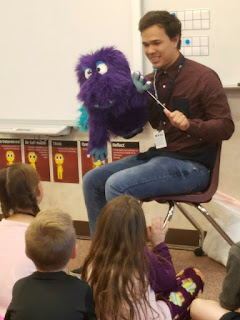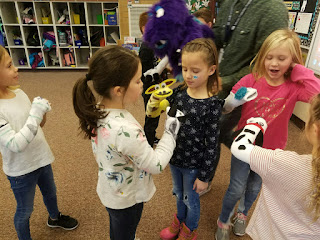Play On - Arts Bridge Blog
Saturday, January 5, 2019
Lessons 5-10
The rest of my Arts Bridge experience was full of learning and growth. The lessons focused first on community and then puppetry and social skills. The final lesson included short puppet plays that included character, setting, problem and solution. I am incredibly grateful for this opportunity.
Friday, October 26, 2018
Lesson 4 - Set Designers
October 12, 2018
This lesson did not go according to plan, but I was able to learn a lot from the experience. Before jumping into the lesson, I invited the students to shake out their limbs so they could move their bodies before sitting and listening to a story. I noticed that many of the students were reluctant to follow my instructions and it seemed that they were tired.
To make a connection to set design, I decided to read a picture book to the class and discuss how setting played an important role in storytelling. I thought the book would help keep the students engaged, but it seemed to do the opposite. I realized that the storytelling was taking much longer than I anticipated, and I was quickly losing the focus of the students, so I skipped ahead in the books to only look at the pictures to determine setting.
Next, I asked the students of different settings in the community (stores, school, police station, hospital, etc). I wrote a few on the board and assigned each of them to different groups. I should not have done that. Almost none of the groups were happy with the set I assigned to them and ultimately most of them decided to design another one. I was attempting to add structure to the lesson so the students would not feel lost choosing a set. I realize now that I should have wrote a few on the board and then let the students CHOOSE which one they wanted to do, or even choose one that was not on the board as long as it was part of the community. I learned that there needs to be a balance between structure and choice.
Once the students started building their model sets, they became more engaged and excited. I tried to integrate some Social Science into the lesson, so I went around and asked groups to describe ways in which people have modified the physical environment to build their community (Social Science Standard 3 Objective 1c). Unfortunately, we ran out of time before sufficient progress could be made on the sets. Thankfully, the teacher gave the students time the following week to work on their sets. This lesson was important because it discussed another type of designer, but also because it integrated community and sets which we will be using for the next lesson.
I wish that I had not used a picture book in this lesson. I think the idea was good, but in practice it did not assist in the learning. Books are great with process drama because the students are able to be more active and involved in the learning. In this setting, I should have used the book solely to look at pictures, or I should have used another pre-text to help the students understand sets. This would have cut down the time spent on lecturing and given more time to the actual set construction. Although I made mistakes and the lesson did not go as planned, I learned a lot and I think the students did too.
Lesson 3 - Costume and Character
October 5, 2018
To continue a discussion on character, I decided to teach about costumes and how they reveal information about characters. I began with a matching activity to introduce the topic. Next, I explained that in theatre we have actors, but we also have designers that use their imaginations and creativity to build things that help tell the story.
 Then, each of the students were able to design their own costumes on a printed outline of a body. The designs included a wide variety of characters including clowns, policemen, mermaids, pirates, and zombies. While they were designing, I went around and talked to each student about their costume and how it revealed character.
Then, each of the students were able to design their own costumes on a printed outline of a body. The designs included a wide variety of characters including clowns, policemen, mermaids, pirates, and zombies. While they were designing, I went around and talked to each student about their costume and how it revealed character.
For the next activity, I asked the students to find partnerships. One would be the costume designer while the other would be the actor wearing the costume. My directions were not clear because I had to restate them multiple times before the students finally understood what I was expecting of them. Using construction paper, markers, and tape, the students built parts of the costumes and shared their designs with the class.


Friday, October 12, 2018
Lesson 2 - Character and Voice
September 28, 2018
Building off last weeks lesson, this week we continued building an actor's toolbox with voice and character. We began with a rhythmic activity to warm up our bodies and voices. Then, we reviewed the vocabulary of last week: actor, body, imagination, and creativity.
When I introduced voice, I focused on two aspects of voice: projection and diction. I helped them practice saying the words and then practice using them by saying sentences like, "Hello Mr. A" or "Today is Friday!"
Next we learned about character and how an actor uses their body and voice to show character. To practice this, I borrowed an activity created by Julia Ashworth. This activity invited students to become polar bears. "Bear in There" by Shel Silverstein was used to encourage students to explore different character choices.
The most successful part of the lesson was when I went around and interacted with each "polar bear." The student LOVED roaring and me and doing a short improvisation with me. Their enthusiasm and spectacular focus and determination informed me that they understood character and using their imagination.
I concluded the activity by asking how they felt being a polar bear. I also asked them how they used their imaginations and why imaginations are important.
I learned to be adaptable from this lesson. I had less time than I expected, and I was in a new location. I also learned how to kindly invite shy or quiet students to participate.
Wednesday, October 3, 2018
Lesson 1 - Body and Imagination
September 21, 2018
The night before my first lesson, I was nervous beyond belief. I am so passionate about education and theater, and I worried that my teaching would not reflect this. After conversing with a friend and giving myself a pep talk, I felt confident and ready to teach.
 After playing a game to help the students be focused and use their bodies, I invited them to gather around me to learn more about theater. I explained that theater is an art form like visual arts, music, and dance. The main difference is that theater uses bodies, voices, and minds to tell a story. I continued by asking if they knew what an actor was and invited the students to pull out their actor's toolbox. This imaginary toolbox contained tools like body, imagination, and creativity.
After playing a game to help the students be focused and use their bodies, I invited them to gather around me to learn more about theater. I explained that theater is an art form like visual arts, music, and dance. The main difference is that theater uses bodies, voices, and minds to tell a story. I continued by asking if they knew what an actor was and invited the students to pull out their actor's toolbox. This imaginary toolbox contained tools like body, imagination, and creativity.
The students helped me define each of these words and I included that the students use these three words every day when they are playing or pretending. This helped the students make a connection between theater and their own life.
 Then, I invited them into the "area of imagination" and asked them to walk. Next, I asked them to pretend that the floor was made of grass, ice, marshmallows, lava, etc. I reinforced that they should show me with their bodies and not their voices. I was worried that I was moving too fast so I next asked them to show me how they were feeling with different frozen images. The students were very expressive in both activities!
Then, I invited them into the "area of imagination" and asked them to walk. Next, I asked them to pretend that the floor was made of grass, ice, marshmallows, lava, etc. I reinforced that they should show me with their bodies and not their voices. I was worried that I was moving too fast so I next asked them to show me how they were feeling with different frozen images. The students were very expressive in both activities!
I ended the lesson with an assessment that used pantomime. I asked each of them to say their name and act out something they enjoyed doing. Then, everyone would repeat the movement. This helped me to learn names and get to know the students better. This assessment took me much longer than I anticipated. Thankfully, the students were focused and attentive throughout.
I had a great experience with my first lesson. The students were engaged through the entire lesson and understood the concepts well. I thought my classroom management was effective and encouraging.
Subscribe to:
Posts (Atom)
Lessons 5-10
The rest of my Arts Bridge experience was full of learning and growth. The lessons focused first on community and then puppetry and social s...

-
October 12, 2018 This lesson did not go according to plan, but I was able to learn a lot from the experience. Before jumping into the les...
-
September 28, 2018 Building off last weeks lesson, this week we continued building an actor's toolbox with voice and chara...
-
September 21, 2018 The night before my first lesson, I was nervous beyond belief. I am so passionate about education and theater, and I w...













































